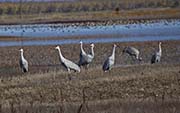Sandhill Crane - Grus canadensis
| Length | |
| Wingspan | |
| Weight | |
| Clutch Size | |
| Chicks at birth | |
| IUCN Conservation Status | |
Continents: |
Sandhill Cranes have the largest population of all the cranes. There are six sub-species of Sandhill Cranes. The different sub-species vary quite a bit in size and weight with the larger sub-species breeding farther south. They are mostly found in North America and northeastern Siberia.
The sexes are similar but the male is slightly larger. The body is various shades of gray (mostly light gray). The forehead and crown are red and the bill is long and dark colored. The iris is reddish-orange, the legs and feet are gray. Juveniles are similar but have both reddish brown and gray feathers. Adults will sometimes have feathers that look brown but this is due to mud staining the feathers.

















